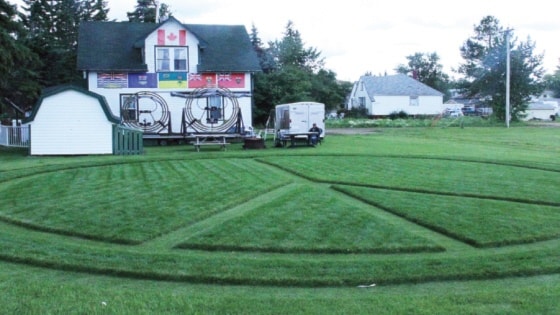Wade Collinge’s front lawn is cut in the shape of a peace sign. A peace sign is painted on his outdoor table, and a flag with a peace sign is fixed on the back of a sign facing his house. Instead of security bars, metal peace signs block every first floor window. Peace signs dangle from Collinge’s car mirror, and a peace sign is embroidered on his hat.
As Collinge says, “It’s not so much the trinket that you have, it’s the story behind it.”
The story behind Collinge’s peace signs began in May 2008. He wanted to name his house and put the name on a sign, which according to town sign bylaws requires a permit. Applying for a permit would have cost $25, said Collinge, and there’s no guarantee the sign will be approved by the town’s Development officer or municipal planning commission.
“It wasn’t about the money,” said Collinge.
When his daughter was younger, Collinge said she would pose in photos with her index and middle finger raised - the peace sign. With her in mind, he decided to cut a peace sign on his lawn.
“It wasn’t so much to protest as I wanted to do something different without having to ask permission,” said Collinge.
He put a stake in the ground where he wanted the peace sign’s centre, and measured 25 feet from it. With that distance, he used spray paint to mark a circle around the centre. Finally, he used his tradesman’s training to draw the straight lines inside the circle by sight. He changed the height settings on his lawn mower to create the definition between the shorter grass of the peace sign and the longer grass inside it.
He phoned his daughter as soon as he’d finished.
“I said, ‘Hey girl, I just cut a 50-foot peace sign in the front lawn of the White House,’” said Collinge, referencing a name he used to call the house when it was completely white.
He daughter told him it was the 50th anniversary of the peace sign, as detailed in a Reader’s Digest article at the time, and which had been unknown to Collinge. That same year also happened to be when Collinge turned 50, which he took to be significant. He has maintained the peace sign ever since.
According to the Reader’s Digest article, the peace sign was created in Britain in 1958 as a symbol for a protest against weapons of mass destruction. The protestors referred to themselves as the “Campaign for Nuclear Disarmament” (CND). The peace sign was designed with a circle to represent the circle of life. The lines inside stand for the flag semaphore symbols for N and D, meaning nuclear disarmament.
“I asked many people if they knew the history, and they didn’t,” said Collinge, who has researched it. He added that only a few people have known the symbol’s significance, all of whom have been from Britain.
“I haven’t had one negative comment. On a nice day it’s nothing to have 50 people say, ‘Hey, that looks great,” said Collinge. “I have to say, it’s got to rank right up there as one of the most photographed things in Sylvan Lake.”
In addition to the photos, Collinge said many children like to run around in the peace sign’s circle. Other people flash the hand symbol for peace as they drive by Collinge’s house.
“One lady going by once said, ‘I really like your lawn, I’m a child of the ‘60s,” said Collinge. He added that another passerby thought the sign was the Mercedes-Benz symbol. Collinge said town workers have also had positive comments about his peace sign.
To maintain it, Collinge said he uses some fertilizer on the longer grass. He cuts it every two to three days in the spring, and once a week in the summer.
A number of people, animals, and objects have had their pictures taken on the peace sign, said Collinge. The list includes people from out of town, classic cars, horses, and bikini-clad women celebrating a bachelorette party.
On Canada Day two years ago, Collinge had a group of friends who wanted to fill the entire peace sign with people. One friend laid down in the cut grass, then the others joined him. After everyone present had taken their position, there was still space left over, so some passersby helped to fill the sign.
“It’s just weird what it’s turned into. It’s like a landmark,” said Collinge, adding that some of his daughter’s friends from the University of Alberta had heard about the peace sign.
Collinge wears a hat he had custom-made for Canada Day 2011. The hat features the peace sign, with the day it was created and the letters CND, for the Campaign for Nuclear Disarmament.
Collinge also made the peace sign security bars in his first floor windows himself.
